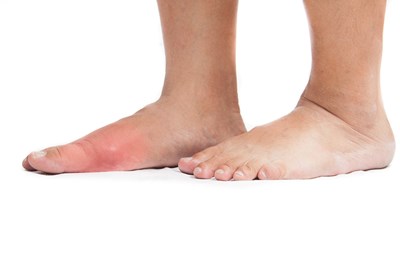Gout is a form of inflammatory arthritis caused by a buildup of uric acid in the blood. In some cases, this is because the body makes too much, while in other instances the kidneys cannot properly flush an appropriate amount of uric acid out of the body.
Sharp urate crystals form in the joints because of gout, causing intense and sometimes long-lasting pain. There are several treatment options for managing and preventing this disease, largely concerned with controlling the pain or the amount of uric acid made or excreted by the body. Here is a look at some of the most common symptoms.
Pain
The buildup of uric acid that causes urate crystals in the joints or surrounding tissue doesn’t happen immediately. The longer gout goes on, especially untreated, the more areas are affected—and more severely. Because of this, the onset of gout is often noticed by the appearance of a sharp pain in the big toe in the early hours of the morning, often waking the affected person from sleep.
As gout progresses, it may appear in additional joints; often only one joint at a time. While the big toe is the most commonly affected, urate crystals may also form in the other toes, fingers, ankles, wrists, knees, and elbows.
Chronic Discomfort
Generally, this pain is the worst at the immediate onset of the condition. It may lessen in severity after that, but the discomfort will often stick around for several days or weeks. More advanced cases of gout will not only appear in multiple joints at once, but may begin to last for longer and longer periods of time.
Eventually, the discomfort can become constant. Externally, the joint may appear swollen, red, and hot or tender to the touch as a response to the internal inflammation caused by sharp urate crystals. As the pain becomes more severe or extended, those suffering from gout may find their mobility decreased as a direct result.
Gout Complications
Excessive uric acid left untreated can cause more difficulties than just gout. Urate crystals can begin to form under the skin, causing visible lumps called “tophi.” These are generally not painful, but can be unsightly and often collect around the joints. During episodes of gout pain, trophi may become inflamed or sore. Moreover, if the excess of uric acid isn’t dealt with, urate crystals may build up in the kidneys as well, causing kidney stones, which are extremely painful to pass.
Some people with too much uric acid may never have to deal with gout; in other cases, symptoms may be present without excessive uric acid. Gout may appear once and never again. Regardless, if you notice intense, long lasting pain or discomfort in a joint—especially beginning in the big toe—it’s a good idea to seek medical advice in order to avoid the pain and potential complications that come with recurrent flare ups.



